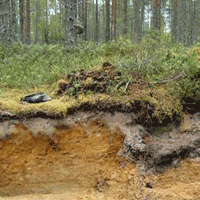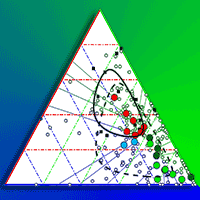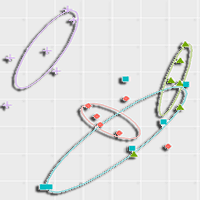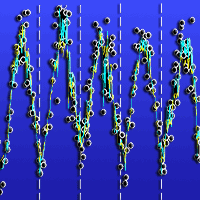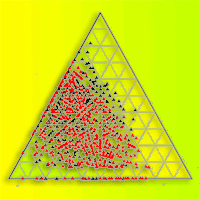Semi-arid areas are particularly susceptible to the loss of biodiversity as a consequence of global change. Species functional traits are key drivers of functioning and resilience of ecosystems, thus monitoring of functional trait diversity is urgently needed. The assessment of functional diversity requires the quantification of species and/or their traits in the field, though there is no consensus on the best plant-sampling method to be used. The aim of this study was to compare the performance of the point-intercept (PT) method with two area-based approaches, the modified-Whittaker (MW) and Dengler (DE) methods, to assess functional diversity in semi-arid areas. The herbaceous community of a savanna-like Mediterranean woodland was surveyed at the two extremes of a regional precipitation gradient (dry to wet). Efficiency in the quantification of species/ traits, precision of cover estimates, and their effect on functional diversity metrics computed for eight functional traits were compared. Results showed that the examined methods differed in their efficiency in quantifying species/traits in both sites. With the DE method, fewer species were detected than with the MW and PT methods, which yielded similar values. The PT method had a higher precision in the quantification of both dominant and non-dominant species/traits. It also had a higher community evenness, mainly in the wet location, which allowed the analysis of a greater number of species/traits within the 80% “dominance” threshold (i.e., species representing 80% of the relative cover of community), a critical aspect of functional diversity assessments. In addition, the PT method yielded higher estimates for multi-trait functional evenness, as well as different estimates (either higher or lower than MW and DE) of single-trait community weighted means (for N-fixing ability and flowering onset), functional dispersion (for N-fixing ability and specific leaf area), and functional evenness (for height and flowering onset). In spite of the observed differences among methods in the assessment of functional diversity, the PT approach demonstrated important advantages in the non-destructive, fine-scale monitoring of semi-arid areas, where “less dominant” species may play a critical role.
Keywords
, , , , , , ,
Citation
Nunes A, Tápia S, Pinho P, Correia O, Branquinho C (2014). Advantages of the point-intercept method for assessing functional diversity in semi-arid areas. iForest 8: 471-479. - doi: 10.3832/ifor1261-007
Academic Editor
Elena Paoletti
Paper history
Received: Feb 02, 2014
Accepted: Jul 16, 2014
First online: Oct 31, 2014
Publication Date: Aug 02, 2015
Publication Time: 3.57 months
© SISEF - The Italian Society of Silviculture and Forest Ecology 2014
Open Access
This article is distributed under the terms of the Creative Commons Attribution-Non Commercial 4.0 International (https://creativecommons.org/licenses/by-nc/4.0/), which permits unrestricted use, distribution, and reproduction in any medium, provided you give appropriate credit to the original author(s) and the source, provide a link to the Creative Commons license, and indicate if changes were made.

Breakdown by View Type
(Waiting for server response...)
Article Usage
Total Article Views: 58876
(from publication date up to now)
Breakdown by View Type
HTML Page Views: 49152
Abstract Page Views: 3241
PDF Downloads: 5082
Citation/Reference Downloads: 45
XML Downloads: 1356
Web Metrics
Days since publication: 4046
Overall contacts: 58876
Avg. contacts per week: 101.86
Article Citations
Article citations are based on data periodically collected from the Clarivate Web of Science web site
(last update: Mar 2025)
Total number of cites (since 2015): 12
Average cites per year: 1.09
Publication Metrics
by Dimensions ©
Articles citing this article
List of the papers citing this article based on CrossRef Cited-by.
(1)
Abrahamson IL, Nelson CR, Affleck DL (2011)Assessing the performance of sampling designs for measuring the abundance of understory plants. Ecological Applications 21 (2): 452-464.
CrossRef |
Gscholar
(2)
Adler PB, Levine JM (2007)Contrasting relationships between precipitation and species richness in space and time. Oikos 116: 221-232.
CrossRef |
Gscholar
(3)
Aronson J, Shmida A (1992)Plant species diversity along a Mediterranean-desert gradient and its correlation with interannual rainfall fluctuations. Journal of Arid Environments 23: 235-247.
Online |
Gscholar
(4)
Atlas Digital do Ambiente (2011)Climate Atlas of Portugal. Agência Portuguesa do Ambiente (APA), Ministerio do Ambiente, Ordenamento do Territorio e Energia, Governo de Portugal, web site. [in Portuguese]
Online |
Gscholar
(5)
Bernard-Verdier M, Navas ML, Vellend M, Violle C, Fayolle A, Garnier E (2012)Community assembly along a soil depth gradient: contrasting patterns of plant trait convergence and divergence in a Mediterranean rangeland. Journal of Ecology 100: 1422-1433.
CrossRef |
Gscholar
(6)
Castro H (2008)Effects of land use change on plant composition and ecosystem functioning in an extensive agro-pastoral system: plant functional traits and ecosystem processes. PhD thesis, University of Coimbra, Portugal, pp. 144.
Gscholar
(7)
Chapin FS, Zavaleta ES, Eviner VT, Naylor RL, Vitousek PM, Reynolds HL, Hooper DU, Lavorel S, Sala OE, Hobbie SE, Mack MC, Díaz S (2000)Consequences of changing biodiversity. Nature 405: 234-242.
CrossRef |
Gscholar
(8)
Cornelissen JHC, Lavorel S, Garnier E, Díaz S, Buchmann N, Gurvich DE, Reich PB, ter Steege H, Morgan HD, van der Heijden MGA, Pausas JG, Poorter H (2003)Handbook of protocols for standardized and easy measurement of plant functional traits worldwide. Australian Journal of Botany 51: 335-380.
CrossRef |
Gscholar
(9)
De Bello F, Leps J, Sebastia MT (2005)Predictive value of plant traits to grazing along a climatic gradient in the Mediterranean. Journal of Applied Ecology 42: 824-833.
CrossRef |
Gscholar
(10)
De las Heras MM, Saco PM, Willgoose GR, Tongway DJ (2011)Assessing landscape structure and pattern fragmentation in semiarid ecosystems using patch-size distributions. Ecological Applications 21: 2793-2805.
CrossRef |
Gscholar
(11)
Dengler J (2009)A flexible multi-scale approach for standardized recording of plant species richness patterns. Ecological Indicators 9: 1169-1178.
CrossRef |
Gscholar
(12)
Díaz S, Lavorel S, de Bello F, Quétier F, Grigulis K, Robson TM (2007)Incorporating plant functional diversity effects in ecosystem service assessments. Proceedings of the National Academy of Sciences USA 104: 20684-20689.
CrossRef |
Gscholar
(13)
Elmendorf SC, Harrison SP (2009)Temporal variability and nestedness in California grassland species composition. Ecology 90 (6): 1492-1497.
CrossRef |
Gscholar
(14)
Elzinga CL, Salzer DW, Willoughby JW (2001)Measuring and monitoring plant populations. Bureau of Land Management National Business Center, Denver, CO, USA, pp. 477.
Gscholar
(15)
Fischer LK, von der Lippe M, Kowarik I (2013)Urban grassland restoration: which plant traits make desired species successful colonizers? Applied Vegetation Science 16: 272-285.
CrossRef |
Gscholar
(16)
Floyd DA, Anderson JE (1987)A comparison of three methods for estimating plant cover. Journal of Ecology 75: 221-228.
CrossRef |
Gscholar
(17)
Franco JA (1971)Nova flora de Portugal (continente e Açores) [New flora of Portugal (mainland and Açores)]. Sociedade Astória Lda, Lisbon, Portugal, vol. 1-2, pp. 555+659.
Gscholar
(18)
Frenette-Dussault C, Shipley B, Léger J, Meziane D, Hingrat Y (2012)Functional structure of an arid steppe plant community reveals similarities with Grime’s C-S-R theory. Journal of Vegetation Science 23 (2): 208-222.
CrossRef |
Gscholar
(19)
Garnier E, Cortez J, Billès G, Navas ML, Roumet C, Debussche M, Laurent G, Blanchard A, Aubry D, Bellmann A, Neill C, Toussaint JP (2004)Plant functional markers capture ecosystem properties during secondary succession. Ecology 85: 2630-2637.
CrossRef |
Gscholar
(20)
Gerhold P, Price JN, Pussa K, Kalamees R, Aher K, Kaasik A, Partel M (2013)Functional and phylogenetic community assembly linked to changes in species diversity in a long-term resource manipulation experiment. Journal of Vegetation Science 24: 843-864.
CrossRef |
Gscholar
(21)
Giordani P, Brunialti G, Benesperi R, Rizzi G, Frati L, Modenesi P (2009)Rapid biodiversity assessment in lichen diversity surveys: implications for quality assurance. Journal of Environmental Monitoring 11 (4): 730-735.
CrossRef |
Gscholar
(22)
Goodall DW (1953)Point quadrat methods for the analysis of vegetation - the treatment of data for tussock grasses. Australian Journal of Botany 1 (3): 457-461.
CrossRef |
Gscholar
(23)
Grime JP (1998)Benefits of plant diversity to ecosystems: immediate, filter and founder effects. Journal of Ecology 86: 902-910.
CrossRef |
Gscholar
(24)
Hillebrand H, Bennett DM, Cadotte MW (2008)Consequences of dominance: a review of evenness effects on local and regional ecosystem processes. Ecology 89: 1510-1520.
CrossRef |
Gscholar
(25)
Kent M, Coker P (1992)Vegetation description and analysis - a practical approach. John Wiley & Sons, Chichester, UK, pp. 363.
Gscholar
(26)
Laliberte E, Legendre P (2010)A distance-based framework for measuring functional diversity from multiple traits. Ecology 91: 299-305.
CrossRef |
Gscholar
(27)
Laliberte E, Shipley B (2011)FD: measuring functional diversity from multiple traits, and other tools for functional ecology. R package version 10-11.
Online |
Gscholar
(28)
Lavorel S, Grigulis K, McIntyre S, Garden D, Williams N, Dorrough J, Berman S, Quétier F, Thébault A, Bonis A (2008)Assessing functional diversity in the field - methodology matters! Functional Ecology 22: 134-147.
CrossRef |
Gscholar
(29)
Lewontin R (1966)On the measurement or relative variability. Systematic Zoology 15: 141-142.
CrossRef |
Gscholar
(30)
Loreau M (2000)Biodiversity and ecosystem functioning: recent theoretical developments. Oikos 91: 3-17.
CrossRef |
Gscholar
(31)
Maestre FT, Quero JL, Gotelli NJ, Escudero A, Ochoa V, Delgado-Baquerizo M, García-Gómez M, Bowker MA, Soliveres S, Escolar C, García-Palacios P, Berdugo M, Valencia E, Gozalo B, Gallardo A, Aguilera L, Arredondo T, Blones J, Boeken B, Bran D, Conceicao A, Cabrera O, Chaieb M, Derak M, Eldridge D, Espinosa CI, Florentino A, Gaitán J, Gatica MG, Ghiloufi W, Gómez-González S, Gutiérrez JR, Hernández RM, Huang X, Huber-Sannwald E, Jankju M, Miriti M, Monerris J, Mau RL, Morici E, Naseri K, Ospina A, Polo V, Prina A, Pucheta E, Ramírez-Collantes DA, Romão R, Tighe M, Torres-Díaz C, Val J, Veiga JP, Wang D, Zaady E (2012a)Plant species richness and ecosystem multifunctionality in global drylands. Science 335: 214-218.
CrossRef |
Gscholar
(32)
Maestre FT, Castillo-Monroy AP, Bowker MA, Ochoa-Hueso R (2012b)Species richness effects on ecosystem multifunctionality depend on evenness, composition and spatial pattern. Journal of Ecology 100: 317-330.
CrossRef |
Gscholar
(33)
Mason N, Mouillot D, Lee W, Wilson J (2005)Functional richness, functional evenness and functional divergence: the primary components of functional diversity. Oikos 111: 112-118.
CrossRef |
Gscholar
(34)
McIntyre S, Lavorel S (2001)Livestock grazing in sub-tropical pastures: steps in the analysis of attribute response and plant functional types. Journal of Ecology 89: 209-226.
CrossRef |
Gscholar
(35)
Mouillot D, Villéger S, Scherer-Lorenzen M, Mason NWH (2011)Functional structure of biological communities predicts ecosystem multifunctionality. PLoS ONE 6 (3): e17476.
CrossRef |
Gscholar
(36)
Nicolau M (2002)Modeling and mapping the spatial distribution of precipitation. An application to Portugal mainland. PhD thesis, Universidade de Lisboa, Lisbon, Portugal.
Gscholar
(37)
Pakeman RJ, Quested HM (2007)Sampling plant functional traits: what proportion of the species need to be measured? Applied Vegetation Science 10: 93-8.
CrossRef |
Gscholar
(38)
Pielou, EC (1975)Indices of diversity and evenness. In: “Ecological Diversity” (Pielou EC ed). John Wiley & Sons, New York, pp. 5-18.
Gscholar
(39)
Porto M, Correia O, Beja P (2011)Long-term consequences of mechanical fuel management for the conservation of Mediterranean forest herb communities. Biodiversity Conservation 20: 2669-2691.
CrossRef |
Gscholar
(40)
Prieur-Richard AH, Lavorel S, Dos Santos A, Grigulis K (2002)Mechanisms of resistance of Mediterranean annual communities to invasion by Conyza bonariensis: effects of native functional composition. Oikos 99: 338-346.
CrossRef |
Gscholar
(41)
R Core Team (2013)R: A language and environment for statistical computing R Foundation for Statistical Computing, Vienna, Austria.
Online |
Gscholar
(42)
Reynolds JF, Stafford Smith DM, Lambin EF, Turner II BL, Mortimore M, Batterbury SP, Downing TE, Dowlatabadi H, Fernandéz RJ, Herrick JE, Huber-Sannwald E, Jiang H, Leemans R, Lynam T, Maestre FT, Ayarza M, Walker B (2007)Global desertification: building a science for dryland development. Science 316: 847-851.
CrossRef |
Gscholar
(43)
Scheffer M, Carpenter S, Foley JA, Folke C, Walker B (2001)Catastrophic shifts in ecosystems. Nature 413: 591-596.
CrossRef |
Gscholar
(44)
Schleuter D, Daufresne M, Massol F, Argillier C (2010)A user’s guide to functional diversity indices. Ecological Monographs 80 (3): 469-484.
CrossRef |
Gscholar
(45)
Sprent JI, Gehlot HS (2010)Nodulated legumes in arid and semi-arid environments: are they important? Plant Ecology and Diversity 3 (3): 211-219.
CrossRef |
Gscholar
(46)
Stohlgren TJ, Falkner MB, Schell LD (1995)A modified-Whittaker nested vegetation sampling method. Plant Ecology 117 (2): 113-121.
CrossRef |
Gscholar
(47)
Talavera S, Aedo C, Castroviejo S, Romero Zarco C, Sáez L, Salgueiro FJ, Velayos M (1999)Flora iberica. Plantas vasculares de la Península Ibérica e Islas Baleares [Flora iberica. Vascular plants of the Iberian Peninsula and Balearic Islands]. Real Jardín Botánico, CSIC, Madrid, Spain, pp. 34.[in Spanish]
Online |
Gscholar
(48)
Tilman D, Knops J, Wedin D, Reich P, Ritchie M, Siemann E (1997)The influence of functional diversity and composition on ecosystem processes. Science 277: 1300-1302.
CrossRef |
Gscholar
(49)
Verrill S, Johnson RA (2007)Confidence bounds and hypothesis tests for normal distribution coefficients of variation. Communications in Statistics, Theory and Methods 36: 2187-2206.
CrossRef |
Gscholar
(50)
Villéger S, Mason N, Mouillot D (2008)New multidimensional functional diversity indices for a multifaceted framework in functional ecology. Ecology 89: 2290-2301.
CrossRef |
Gscholar
(51)
Vittoz P, Guisan A (2007)How reliable is the monitoring of permanent vegetation plots? A test with multiple observers. Journal of Vegetation Science 18: 413-422.
CrossRef |
Gscholar
(52)
Walker BH, Kinzig A, Langridge J (1999)Plant attribute diversity, resilience, and ecosystem function: the nature and significance of dominant and minor species. Ecosystems 2: 95-113.
CrossRef |
Gscholar



